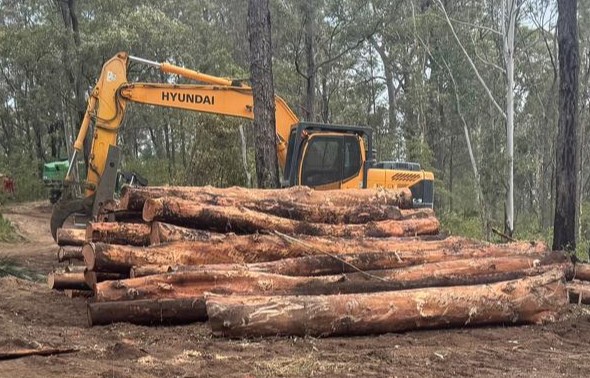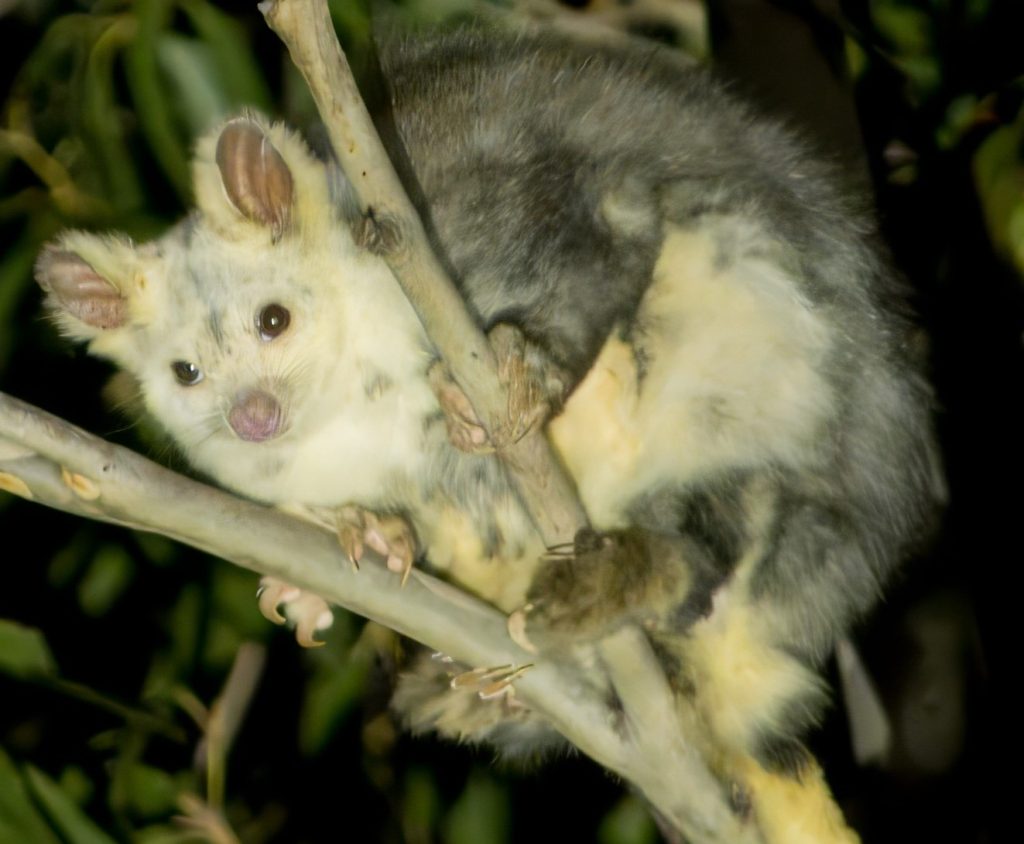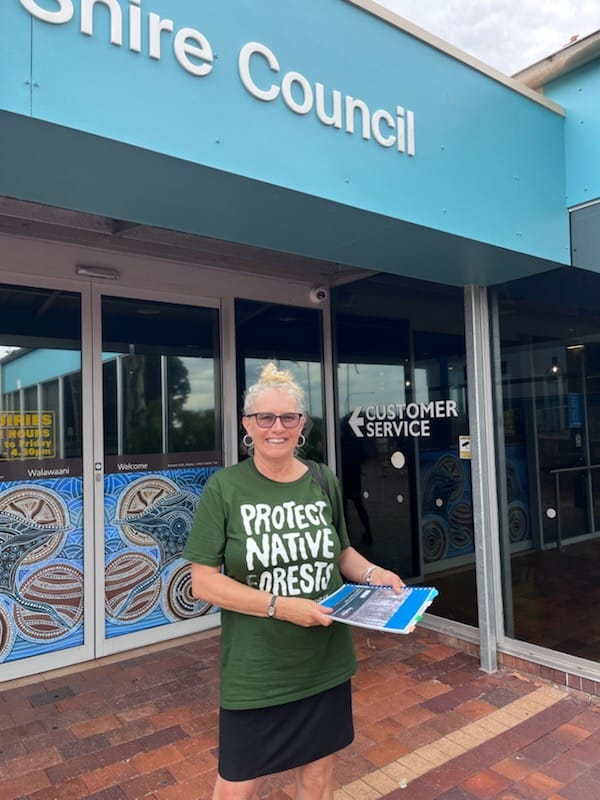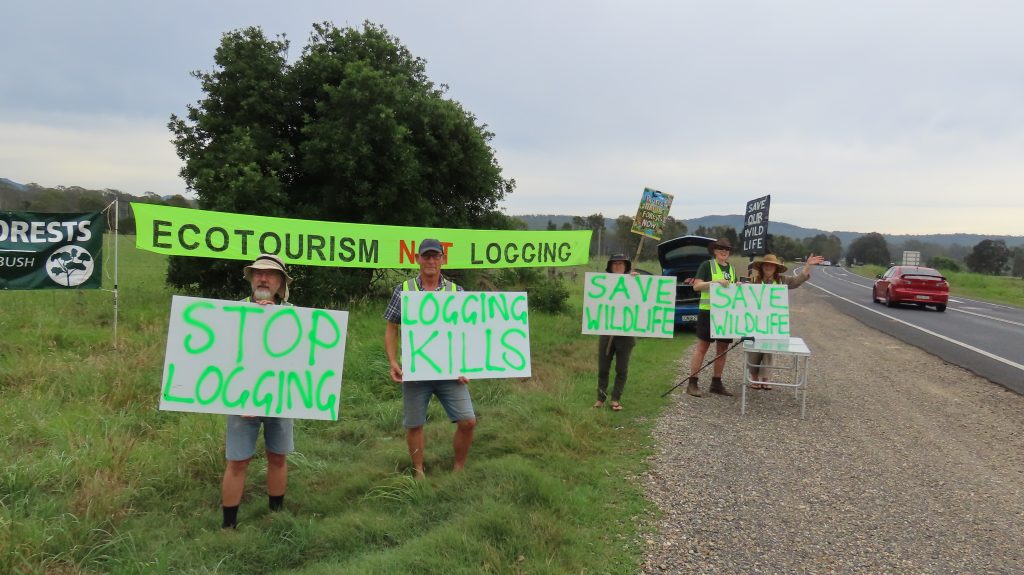At the Public Access Session of Eurobodalla Shire Council on Tuesday Joslyn Van der Moolen was one of several residents to address the Council, on two matters:
- Friends of the Forest (Mogo) Emergency Forest Embassies on the corner of Larrys Mountain Road and the Princes Highway since 26 November to protest against the logging 10 minutes nw of Moruya in November 2024. The public have been enthusiastically responding with honks and many many waves and thumbs up of support. Stopping Logging will negate over half of Eurobodalla’s Carbon Emissions
- Securing Mountain Bike Trail Tenure in State Forests
“Welcome Mayor, Deputy Mayor and returning Councillors, staff and the public. Some of you will know I was the second Greens Candidate in the recent election and I congratulate Colleen Turner for being elected to continue the Greens legacy of previous Greens Councillors including outgoing Deputy Mayor Alison Worthington. I am speaking to you in my role on the Coastwatchers Forest Working Group and Community Liaison for Friends of the Forest (Mogo).
Mogo State forest to the north of the Moruya river between Mogendoura and North Moruya started being logged two weeks ago. This beautiful tall spotted gum forest is going to be logged east of Maulbrooks Rd up to RHA Fire Trail at the top of the mountain range across to the Eurobodalla Archery Range.
This Mogo State Forest operation of 534 hectares is part of 110,000 hectares of public state forest that covers 31% of the Eurobodalla. There are two critical areas that logging impacts on the Eurobodalla Shire Council. The first is logging emissions in relation to the council’s Eurobodalla Climate Action Plan 2022 – 2032. The second is the need to secure tenure for the mountain bike trails that council has invested in, so these mountain bike trails are not closed for months or damaged by industrial logging machinery.

The Climate Action Plan shows the total carbon emissions for the Eurobodalla shire (page 11) from Electricity, Transport, Waste, Agriculture and Gas in 2019/2020 (the same year as the Black Summer fires) was 396,000 tonnes. This plan also states that these figures exclude emissions from land use change and forestry.
So let’s see what happens if we include carbon emissions from logging our forests that are in the Zero SE State Forest and Climate Action in Eurobodalla fact sheets. These fact sheets use the same Snapshot emission figures as the council Climate Action Plan.
The Frontier Economic Report Comparing the value of alternative uses of native forests in Southern NSW, calculated the annual emissions from logging in southern NSW was 950,000 tonnes. The Eurobodalla Shire has 106,462 hectares of state forest. 106,462 hectares is 26% of the total 411,651 hectares in southern NSW (the Eden and Southern, Regional Forest Agreement areas).
So, since the Eurobodalla has a 26% of the forest being logged in southern NSW the Eurobodalla is generating a quarter of the 950,000 tonnes of carbon emissions from logging each year. Twenty-six per cent of the total emissions of 950,000 tonnes for southern NSW is 245,691 tonnes pa. So, in 2018-2019 the Eurobodalla was generating 438,000 tonnes of annual emissions from Electricity, Transport, Waste, Agriculture and Gas. So, if we stop logging, we will no longer generate 245,691 tonnes of carbon emissions per annum. This carbon emissions saving of 245,691 tonnes will negate over half of the Eurobodalla’s emissions from Electricity, Transport, Waste, Agriculture and Gas. This incredible result is also reflected in the Bega shire that has even more state forest and logging.

The need to secure tenure for mountain bike trails in our state forests
Nature based tourism is our main economic driver with at least $16 million invested in Eurobodalla mountain bike trails in Mogo and Narooma. The Council’s Mogo Trails webpage shows the Mogo Trails project was made possible due to $5 million from the Australian and NSW Governments’ Bushfire Local Economic Recovery Fund and $3 million from the NSW Government’s Growing Local Economies Fund.
This has attracted the prestigious international Sea Otter event in Mogo State Forest in October 2025.
Despite this infrastructure investment and event planning the state forest mountain bike trails are not protected from being damaged by logging. We need to protect these state forests to safeguard this investment and provide certainty to the industry, so these mountain bike trails are not logged in the future. Without protection, these forests will be closed for months and months for logging and tracks damaged.
In state forests, protected areas are called Preserved Forest Areas as has been allocated, around the convict built Old Coach Road in Termeil leading to Big Spotty.
When Mogo State Forest at Dunns Creek was logged in 2018, Forestry put signs up saying the track was closed for nine months. The informal Joan of Arc trail and Vietnam trail maintained by volunteers, were driven over by heavy industrial logging machinery. When the tracks opened the tracks along the creek had grown over for over a kilometre.
Managers of the mountain bike trails are key stakeholders and have the power to negotiate protection of forests that have mountain bike infrastructure. The council need to demand that this investment be matched by Forestry Corporation NSW (a NSW Government entity) and mountain biking forests be protected as a Forest Preserved area.
Our forests must be kept standing for biodiversity, as carbon storage and for eco-tourism our main industry. The forestry industry must focus 100% on plantations that are profitable, that already provide over 80% of construction timber and many skilled jobs and use less land. AKD softwoods in Tumut own 12,000 hectares on plantations that pay rates to local shires in Tumut and Oberon.
Joslyn van der Moolen
Secretary Coastwatchers and Forest Working Group member
Community Liaison Friends of the Forest (Mogo)

REFERENCES:
Frontier Economics & Macintosh, A (2021), p35 Comparing the value of alternative uses of native forests in Southern NSW
Eurobodalla Shire has 106,462 hectares of state forest (26% of the total 411,651 ha) of the Eden and Southern Regional Forest Agreement areas in southern NSW. Carbon abatement from stopping logging is equivalent to 56% of annual emissions from electricity, transport, waste, agriculture for the Eurobodalla shire. See Zero SE State Forest factsheet
Twenty six per cent of the total carbon abatement of 950,000 tonnes for southern NSW is 245,691 tonnes pa. 245,691 tonnes pa of avoided emissions will negate 56% of the 438,000 tonnes of annual emissions (2019 figures https://snapshotclimate.com.au/) (245,691/438,000 = 56%) from electricity, transport, waste, agriculture for the Eurobodalla shire.
Bega Shire has 140,490 hectares of state forest (34% of the total 411,651 ha) of the Eden and Southern Regional Forest Agreement areas in southern NSW. Carbon abatement from stopping logging, is equivalent to 66% of annual emissions in the shire.
Thirty four per cent of the total carbon abatement of 950,000 tonnes for Southern NSW is 324,197 tonnes pa, which would be equivalent to 66% of the annual 494,000 tonnes (2019 figures https://snapshotclimate.com.au/) of annual emissions (324,197/494,000 = 66%) from electricity, transport, waste, agriculture and gas for the Bega shire.
Shoalhaven Shire has 52,052 hectares of state forest (13% of the total 411,651 ha) of the Eden and Southern Regional Forest Agreement areas in southern NSW. Carbon abatement from stopping logging, is equivalent to 9% of annual emissions in the Shoalhaven.
14 Oct 2022 Stopping native forest logging is the only way to meet our net zero targets Canberra Times, Lindenmayer/Mackay Stopping Logging will save 15.3mt pa for 9 years and meet 43% reduction in GHG by 2030 below 2005 level…. there are many sources of emissions, only native forests can remove carbon at the scale and time required.
Lean Ending native forest logging and moving to 100% plantations would save 225 million tonnes of emissions from now (7 Aug 2023) until 2050.
NSW FOREST CARBON REPORT SUMMARY 2023 – The Tree Projects Research conducted for this report found that greenhouse gas emissions from native forest logging in New South Wales is approximately 3.6 million tonnes of carbon (CO2 e) per year. This shows that native forest logging in New South Wales is a significant source of emissions. It has the same annual emissions as 840,000 medium sized cars or is close to four and a half times the annual emissions of New South Wales’ domestic aviation. This figure is based on ‘short-term’ and ‘long-term’ emissions. Around 64% of a forest’s carbon is released within a few years of logging. Most of the wood removed from New South Wales’ forests goes into single-use products such as paper, which have a short lifespan. As much as 40% of the forest’s biomass is incinerated, which immediately emits carbon dioxide, methane and nitrous oxides in to the atmosphere. Long-lasting wood products such as sawn timber only represent about 4-8% of the forest’s carbon.
Around 30% of the forest’s biomass, mainly consisting of woody debris and stumps, gets left behind on-site after burning. This can take up to 50 years to break down and emit the stored carbon. Currently in New South Wales, forests containing 2.2 million tonnes of carbon (CO2 e) are logged each year. However, annual emissions are estimated to be higher due to the lag effects of waste breaking down on-site from decades-old logging when the rate of harvest was twice as high. When forests are logged, two-thirds of the carbon is released within two years. Some of these carbon dioxide emissions will be recovered as some native forests regrow after logging. However, it takes many decades to centuries for forests to capture lost carbon. We cannot wait decades to centuries.
We need to reduce emissions now to prevent catastrophic climate change. Protecting New South Wales’ native forests is a real climate solution. If native forests currently managed for logging were protected, we could prevent 76 million tonnes of carbon (CO2 e) from entering the atmosphere by 2050. This could provide close to $2.7 billion in benefit to help mitigate climate change. Our smartest choice would be to protect New South Wales’ native forests – this will prevent significant emissions and allow forests to continue to draw carbon down from the atmosphere.

